DSO–TSO Coordination of Day-Ahead Operation Planning with the Use of Distributed Energy Resources
Abstract
1. Introduction
- Close cooperation between Transmission System Operator (TSO) and Distribution System Operators (DSOs);
- Dealing with the fluctuations coming from weather-dependent renewable generation;
- Coordinated planning and real-time management of the operation of various resources across transmission and distribution systems for achieving joint targets;
- Dealing with the uncertainty coming from predictions of weather-dependent renewable generation and load.
- Proposes a bilevel coordination of day-ahead operation planning of transmission and distribution systems, where TSO has a possibility to select an 24-h power profile at each transmission–distribution (T–D) substation interface to be realized on the next day;
- Presents an optimization model that is used by DSO to form a bid of possible smoothed 24-h power profiles at his T–D interface;
- Presents modifications in the ‘classical’ Unit Commitment (UC) problem, which are needed to serve appropriately the bids submitted by all DSOs;
- Validates the optimization model for shaping a modified 24-h power profile at the T–D interface throughout simulations carried out on a power system model.
- The proposed DSO–TSO coordination is a developed version of the shared balancing responsibility model [16] and can be easily adopted to the LINK-based holistic architecture of the power system [17]. It deals with the variability of the residual load to be covered by conventional power plants and includes: the cost-effective agreeing the 24-h schedules at T–D interfaces and coordination of operation between different DERs and power plants. So far, all these issues have not been considered together in one concept and in that form as presented here.
- The proposed optimization model includes both a new formulation of the non-cost-oriented quadratic objective function for smoothing the 24-h power profile at the T–D interface and more developed operation models of various DERs. These models involve: time-based dependencies of DERs’ operation (ramp rates, minimum online and offline times and states of the charge of energy storage systems); remuneration of DERs for their involvement in shaping the profile at the T–D interface and limitation of the transfer of the cycling operation (defined as frequent changing of the output power by starting up, shutting down, ramping up and ramping down [59]) from conventional power plants to DERs. So far, such an optimization model has not been proposed in the literature.
2. Methodology
2.1. DSO–TSO Coordination of Day-Ahead Operation Planning
- First step—where day-ahead operation planning of local DERs was executed several times by each DSO in order to create several various and possible 24-h power profiles at its T–D interface for the next day.
- Second step—where day-ahead operation planning of power plants was specified by TSO for the next day (business as usual) but, additionally, there was a selection of 24-h power profiles to be realized at T–D interfaces.
2.1.1. First Step of the Coordinated Day-Ahead Planning
- One non-modified 24-h power profile at T–D interface;
- Several modification/variations of the profile.
A Modified Profile at the T–D Interface
- DSOs are obliged to compensate deviations of real values from their projections if they come from their distribution system and;
- DSOs are obliged to make it possible to offer, e.g., frequency ancillary services by the distributed energy resources.
Design of a DSO Bid
- At first, the non-modified 24-h power profile at the T–D interface is created;
- Then, the first modified profile is created without the limit on the total cost of deviations of the DERs’ output powers. It enables the optimization model to shape the profile as smooth as possible but with the restriction on the total energy transfer to be not higher than the energy in the non-modified profile;
- Finally, other modified profiles are created with the increasingly stringent limits on the total cost per each next profile. These limits were calculated basing on the obtained cost in the first modified profile. The restriction on the total energy transfer was still binding.
2.1.2. Second Step of the Coordinated Day-Ahead Planning
- Commitment and dispatch of conventional power plants on day d (business as usual);
- 24-h power profiles to be realized at T–D interfaces on day d (novelty).
- The cost of selected power profiles at T–D interfaces to the minimized objective function;
- Decision variables and equations that allow for selecting which 24-h profile from all submitted by a given DSO in his bid is to be realized during the next day.
2.2. Optimization Models Included in the DSO–TSO Coordination of Day-Ahead Operation Planning
2.2.1. Optimization Model for Generating a Modified Profile at the T–D Interface
- Objective function;
- Power at the T–D interface;
- Technical constraints on the operation of biofuel-fired electricity sources, energy storage systems, PV, wind turbines and active consumers, including limitations of their cycling operation;
- Remuneration models of DERs;
- Cost constraint of the 24-h power profile at the T–D interface;
- Required minimum level of upward and downward power reserved in DERs.
Objective Function
Power at the T–D Interface
Bio-Fuel Fired Electricity Sources
PV and Wind Turbines
Energy Storage Systems
Active Consumers
Minimum Level of Power Reserved in DERs
Remunerations of DERs
- For the energy storage system, it is the state of the charge that results from earlier concluded commercial contracts on purchase and selling energy;
- For other DERs, they are output powers that result from energy market contracts, bilateral contracts or some law regulations (e.g., priority dispatch of RESs).
Cost of the Modified Profile at the T–D Interface
- —the remuneration of energy storage system s at time t;
- —the remuneration of bio-fuel electricity source g at time t;
- —the remuneration of renewable energy source r at time t;
- —the remuneration of active consumer j at time t.
2.2.2. Extension of the Unit Commitment Problem
3. Numerical Results and Their Discussion
- A reduction of the demand for operation flexibility at the transmission system level;
- A decrease of the number of conventional power plants that are required to ensure the load-generation balance in the power system during a day;
- An extension of the set of tools that can be used to manage congestions in the transmission network at the stage of operation planning.
- The 1st step consisted in the generation of several possible 24-h profiles at the T–D interface of a distribution system model. The non-modified 24-h power profile was constructed as the difference between loads and self-dispatched operation of DERs in the distribution system model. Modified power profiles were generated using the optimization model described in Section 2.2.1. Each generated profile posed a separate simulation scenario.
- The 2nd step consisted in the evaluation of the impact of power profiles generated in the 1st step on the transmission system operation. Within a given simulation scenario, a profile obtained in the 1st step was assigned to all load nodes of a transmission system model. The network-constrained UC problem was solved to make it possible to analyze conditions of the transmission system operation.
- Minimum and maximum output powers of power plants;
- Three temperature-dependent start-up modes of power plants;
- Minimum level of upward and downward power reserved in power plants;
- Maximum upward and downward ramping of output powers of power plants;
- Minimum online and offline times of power plants;
- Minimum number of units operating in each zone of the transmission network;
- Generation and start-up prices of power plants;
- DC power flows and flow limits of the transmission network.
- Reference scenario R1—represents the following self-dispatch of DERs in the distribution system model: PVs and wind turbines operate with the forecasted weather-dependent generation, bio-fuel fired electricity sources operate with their maximum output powers, active consumers do not activate the reduction mode and energy storage systems realize the arbitrage on an energy market. Therefore, the power profile at the T–D interface was determined as the difference between generations and loads in the distribution system model.
- Main scenario S1—the optimization model developed in Section 2.2.1 was applied. Since the cost of DERs’ deviations was unlimited, the capabilities of DERs were used to the maximum for smoothing 24-h power profile at the T–D interface;
- Main scenario S2—the optimization model developed in Section 2.2.1 was applied. The maximum possible cost of DERs’ deviations was limited to be twice lower than the analogous cost obtained in Scenario S1;
- Main scenario S3—the optimization model developed in Section 2.2.1 was applied. The maximum possible cost DERs’ deviations was limited to be four times lower than the analogous cost obtained in Scenario S1.
- In scenario R1 the peak total load in the transmission system model could be met by 80% of total generation capabilities of power plants,
- In scenarios S1, S2 and S3 the total load profile in the transmission system model kept the original proportion to the profile from Scenario R1.
4. Conclusions
Supplementary Materials
Funding
Acknowledgments
Conflicts of Interest
References
- REN21. REN21—2019 Global Status Report; REN21: Paris, France, 2019. [Google Scholar]
- Pérez-Arriaga, I.J.; Ruester, S.; Schwenen, S.; Battle, C.; Glachant, J.-M. From Distribution Networks to Smart Distribution Systems: Rethinking the Regulation of European Electricity DSOs; RSCAS—European University Institute: Firenze, Italy, 2013. [Google Scholar]
- Rehman, S.; Al-Hadhrami, L.M.; Alam, M.M. Pumped hydro energy storage system: A technological review. Renew. Sustain. Energy Rev. 2015, 44, 586–598. [Google Scholar] [CrossRef]
- Cochran, J.; Lew, D.; Kumar, N. Flexible Coal Evolution from Baseload to Peaking Plant; NREL: Golden, CO, USA, 2013. [Google Scholar]
- Kumar, N.; Besuner, P.; Lefton, S.; Agan, D.; Hilleman, D. Power Plant Cycling Costs; NREL: Golden, CO, USA, 2012. [Google Scholar]
- EU. European Union Directive (EU) 2018/2001 on the promotion of the use of energy from renewable sources. Off. J. Eur. Union 2018, 2018, 1–128. [Google Scholar]
- Miller, G. Beyond 100% renewable: Policy and practical pathways to 24/7 renewable energy procurement. Electr. J. 2020, 33, 106695. [Google Scholar] [CrossRef]
- Zappa, W.; Junginger, M.; van den Broek, M. Is a 100% renewable European power system feasible by 2050? Appl. Energy 2019, 233–234, 1027–1050. [Google Scholar] [CrossRef]
- European Union Regulation (EU). 2019/943 of 5 June 2019 on the internal market for electricity. Off. J. Eur. Union 2019, 158, 54–124. [Google Scholar]
- European Union Directive (EU). 2019/944 of 5 June 2019 on common rules for the internal market for electricity and amending Directive 2012/27/EU. Off. J. Eur. Union 2019, 158, 125–199. [Google Scholar]
- Comission Regulation (EU). 2017/1485 of 2 August 2017 on electricity transmission system operation. Off. J. Eur. Union 2017, 220, 1–120. [Google Scholar]
- CEDEC; EDSOE; ENTSO-E; EURELECTRIC; GEODE TSO-DSO. Report—An Integrated Approach to Active System Management; CEDEC–ENTSO-E–GEODE–E.DSO–EURELECTRIC: Berlin, Germany, 2019. [Google Scholar]
- Lind, L.; Cossent, R.; Chaves-Ávila, J.P.; Gómez San Román, T. Transmission and distribution coordination in power systems with high shares of distributed energy resources providing balancing and congestion management services. Wiley Interdiscip. Rev. Energy Environ. 2019, 8, 1–19. [Google Scholar] [CrossRef]
- Nieto-martin, J.; Bunn, D.W.; Varga, L. Design of Local Services Markets for Pricing DSO-TSO Procurement Coordination. In Proceedings of the 2018 IEEE Power & Energy Society General Meeting (PESGM), Portland, OR, USA, 5–10 August 2018; pp. 1–5. [Google Scholar]
- Vicente-Pastor, A.; Nieto-Martin, J.; Bunn, D.W.; Laur, A. Evaluation of flexibility markets for retailer-dso-tso coordination. IEEE Trans. Power Syst. 2019, 34, 2003–2012. [Google Scholar] [CrossRef]
- Gerard, H.; Rivero Puente, E.I.; Six, D. Coordination between transmission and distribution system operators in the electricity sector: A conceptual framework. Util. Policy 2018, 50, 40–48. [Google Scholar] [CrossRef]
- ETIP-SNET. White Paper—Holistic Architectures for Future Power Systems; INTENSYS4EU: Brussels, Belgium, 2019. [Google Scholar]
- Delfanti, M.; Galliani, A.; Olivieri, V. The new role of DSOs: Ancillary services from RES towards a local dispatch. CIRED Work. 2014, 1, 1–5. [Google Scholar]
- Kristov, L.; De Martini, P.; Taft, J.D. A tale of two visions: Designing a decentralized transactive electric system. IEEE Power Energy Mag. 2016, 14, 63–69. [Google Scholar] [CrossRef]
- Le Cadre, H.; Mezghani, I.; Papavasiliou, A. A game-theoretic analysis of transmission-distribution system operator coordination. Eur. J. Oper. Res. 2019, 274, 317–339. [Google Scholar] [CrossRef]
- Yuan, Z.; Hesamzadeh, M.R. Hierarchical coordination of TSO-DSO economic dispatch considering large-scale integration of distributed energy resources. Appl. Energy 2017, 195, 600–615. [Google Scholar] [CrossRef]
- Yan, R.; Saha, T.K. Power Ramp Rate Control for Grid Connected Photovoltaic System. In Proceedings of the 9th International Power and Energy Conference (IPEC), Singapore, 27–29 October 2010; pp. 83–88. [Google Scholar]
- Sangwongwanich, A.; Yang, Y.; Blaabjerg, F. A Cost-effEctive Power Ramp-Rate Control Strategy for Single-Phase Two-Stage Grid-Connected Photovoltaic Systems. In Proceedings of the 2016 IEEE Energy Conversion Congress and Exposition (ECCE), Milwaukee, WI, USA, 18–22 September 2016; pp. 1–7. [Google Scholar]
- Chen, X.; Du, Y.; Wen, H. Forecasting Based Power Ramp-Rate Control for PV Systems Without Energy Storage. In Proceedings of the 2017 IEEE 3rd International Future Energy Electronics Conference and ECCE Asia (IFEEC 2017-ECCE Asia), Kaohsiung, Taiwan, 3–7 June 2017; pp. 733–738. [Google Scholar]
- Alam, M.J.E.; Muttaqi, K.M.; Sutanto, D. A novel approach for ramp-rate control of solar PV using energy storage to mitigate output fluctuations caused by cloud passing. IEEE Trans. Energy Convers. 2014, 29, 507–518. [Google Scholar]
- Akagi, S.; Yoshizawa, S.; Ito, M.; Fujimoto, Y.; Miyazaki, T. Electrical Power and Energy Systems Multipurpose control and planning method for battery energy storage systems in distribution network with photovoltaic plant. Electr. Power Energy Syst. 2020, 116, 105485. [Google Scholar] [CrossRef]
- Salehi, V.; Radibratovic, B. Ramp rate control of photovoltaic power plant output using energy storage devices. IEEE Power Energy Soc. Gen. Meet. 2014, 2014, 1–5. [Google Scholar]
- Zhou, H.; Bhattacharya, T.; Tran, D.; Siew, T.S.T.; Khambadkone, A.M. Composite energy storage system involving battery and ultracapacitor with dynamic energy management in microgrid applications. IEEE Trans. Power Electron. 2011, 26, 923–930. [Google Scholar] [CrossRef]
- Zhao, Q.; Xian, L.; Roy, S. Kong xin optimal control of pv ramp rate using multiple energy storage system. Phys. A Stat. Mech. Appl. 2007, 374, 483–490. [Google Scholar]
- Karmiris, G.; Tengnér, T. Control Method Evaluation for Battery Energy Storage System Utilized in Renewable Smoothing. In Proceedings of the IECON 2013—39th Annual Conference of the 2013 IEEE Industrial Electronics Society, Vienna, Austria, 10–13 November 2013; pp. 1566–1570. [Google Scholar]
- Ahmed, M.; Member, S.; Kamalasadan, S.; Member, S. An Approach for Net-Load Management to Reduce Intermittency and Smooth the Power Output on Distribution Feeders with High PV Penetration. In Proceedings of the 2018 IEEE Industry Applications Society Annual Meeting (IAS), Portland, OR, USA, 23–27 September 2018; pp. 1–9. [Google Scholar]
- Kim, S.K.; Jeon, J.H.; Cho, C.H.; Ahn, J.B.; Kwon, S.H. Dynamic modeling and control of a grid-connected hybrid generation system with versatile power transfer. IEEE Trans. Ind. Electron. 2008, 55, 1677–1688. [Google Scholar] [CrossRef]
- Meng, L.; Dragicevic, T.; Guerrero, J. Adaptive Control of Energy Storage Systems for Power Smoothing Applications. In Proceedings of the 2017 IEEE 3rd International Future Energy Electronics Conference and ECCE Asia (IFEEC 2017—ECCE Asia), Kaohsiung, Taiwan, 3–7 June 2017; pp. 1014–1018. [Google Scholar]
- Kakimoto, N.; Satoh, H.; Takayama, S.; Nakamura, K. Ramp-rate control of photovoltaic generator with electric double-layer capacitor. IEEE Trans. Energy Convers. 2009, 24, 465–473. [Google Scholar] [CrossRef]
- Pascual, J.; Sanchis, P.; Marroyo, L. Implementation and control of a residential electrothermal microgrid based on renewable energies, a hybrid storage system and demand side management. Energies 2014, 7, 210–237. [Google Scholar] [CrossRef]
- Hund, T.D.; Gonzalez, S.; Barrett, K. Grid-Tied PV System Energy Smoothing. In Proceedings of the 2010 35th IEEE Photovoltaic Specialists Conference, Honolulu, HI, USA, 20–25 June 2010; pp. 2762–2766. [Google Scholar]
- Pascual, J.; Barricarte, J.; Sanchis, P.; Marroyo, L. Energy management strategy for a renewable-based residential microgrid with generation and demand forecasting. Appl. Energy 2015, 158, 12–25. [Google Scholar] [CrossRef]
- Arcos-Aviles, D.; Pascual, J.; Guinjoan, F.; Marroyo, L.; Sanchis, P.; Marietta, M.P. Low complexity energy management strategy for grid profile smoothing of a residential grid-connected microgrid using generation and demand forecasting. Appl. Energy 2017, 205, 69–84. [Google Scholar] [CrossRef]
- Aviles, D.A.; Guinjoan, F.; Barricarte, J.; Marroyo, L.; Sanchis, P.; Valderrama, H. Battery Management Fuzzy Control for a Grid-Tied Microgrid with Renewable Generation. Proceedings of IECON 2012—38th Annual Conference on IEEE Industrial Electronics Society, Montreal, QC, Canada, 25–28 October 2012; pp. 5607–5612. [Google Scholar]
- Puri, A. Bounds on the Smoothing of Renewable Sources. In Proceedings of the 2015 IEEE Power & Energy Society General Meeting, Denver, CO, USA, 26–30 July 2015; pp. 1–5. [Google Scholar]
- Reihani, E.; Motalleb, M.; Ghorbani, R.; Saad, L. Load peak shaving and power smoothing of a distribution grid with high renewable energy penetration. Renew. Energy 2016, 86, 1372–1379. [Google Scholar] [CrossRef]
- Li, P.; Dargaville, R.; Cao, Y.; Li, D.; Xia, J. Storage aided system property enhancing and hybrid robust smoothing for large-scale PV systems. IEEE Trans. Smart Grid 2017, 8, 2871–2879. [Google Scholar] [CrossRef]
- Liu, S.; Cao, Z.; Li, J.; Liu, H. Control Strategy of Energy Storage Station to Smooth Real-Time Power Fluctuation. In Proceedings of the 2015 International Symposium on Smart Electric Distribution Systems and Technologies (EDST), Vienna, Austria, 8–11 September 2015; pp. 58–62. [Google Scholar]
- Elghitani, F.; El-saadany, E. Smoothing net load demand variations using residential demand management. IEEE Trans. Ind. Inform. 2019, 15, 390–398. [Google Scholar] [CrossRef]
- Liu, X.; Hua, Y.; Liu, X.; Yang, L.; Sun, Y. Smoother: A Smooth Renewable Power-Aware Middleware. In Proceedings of the 2019 IEEE 39th International Conference on Distributed Computing Systems (ICDCS), Dallas, TX, USA, 7–10 July 2019; pp. 249–260. [Google Scholar]
- Nosratabadi, S.M.; Hooshmand, R.A.; Gholipour, E. A comprehensive review on microgrid and virtual power plant concepts employed for distributed energy resources scheduling in power systems. Renew. Sustain. Energy Rev. 2017, 67, 341–363. [Google Scholar] [CrossRef]
- Khatami, R.; Member, S.; Heidarifar, M.; Member, S. Scheduling and Pricing of Load Flexibility in Power Systems. IEEE J. Sel. Top. Signal Process. 2018, 12, 645–656. [Google Scholar] [CrossRef]
- Majzoobi, A.; Khodaei, A. Application of Microgrids in Addressing Distribution Network Net-Load Ramping. In Proceedings of the 2016 IEEE Power & Energy Society Innovative Smart Grid Technologies Conference (ISGT), Minneapolis, MN, USA, 6–9 September 2016; pp. 1–5. [Google Scholar]
- Majzoobi, A.; Khodaei, A. Application of microgrids in supporting distribution grid flexibility. IEEE Trans. Power Syst. 2017, 32, 3660–3669. [Google Scholar] [CrossRef]
- Lesniak, A. Optimization of the flexible virtual power plant operation in modern power system. Int. Conf. Eur. Energy Mark. EEM 2018, 2018, 1–5. [Google Scholar]
- Gigoni, L.; Betti, A.; Crisostomi, E.; Franco, A.; Tucci, M.; Bizzarri, F.; Mucci, D. Day-ahead hourly forecasting of power generation from photovoltaic plants. IEEE Trans. Sustain. Energy 2018, 9, 831–842. [Google Scholar] [CrossRef]
- Ren, Y.; Suganthan, P.N.; Srikanth, N. Ensemble methods for wind and solar power forecasting—A state-of-the-art review. Renew. Sustain. Energy Rev. 2015, 50, 82–91. [Google Scholar] [CrossRef]
- Fallah, S.N.; Deo, R.C.; Shojafar, M.; Conti, M.; Shamshirband, S. Computational intelligence approaches for energy load forecasting in smart energy management grids: State of the art, future challenges, and research directions. Energies 2018, 11, 596. [Google Scholar] [CrossRef]
- Zakaria, A.; Ismail, F.B.; Lipu, M.S.H.; Hannan, M.A. Uncertainty models for stochastic optimization in renewable energy applications. Renew. Energy 2019, 145, 1543–1571. [Google Scholar] [CrossRef]
- Fair Isaac Corporation (FICO). White Paper—Robust Optimization with Xpress—Usage Guidelines and Examples; Fair Isaac Corporation (FICO): San Jose, CA, USA, 2017. [Google Scholar]
- Taylor, J.A. Convex Optimization of Power Systems; Cambridge University Press: Cambridge, UK, 2015; ISBN 978-1-107-07687-7. [Google Scholar]
- Hussain, A.; Bui, V.H.; Kim, H.M. Robust optimization-based scheduling of multi-microgrids considering uncertainties. Energies 2016, 9, 278. [Google Scholar] [CrossRef]
- Choi, S.H.; Hussain, A.; Kim, H.M. Adaptive robust optimization-based optimal operation of microgrids considering uncertainties in arrival and departure times of electric vehicles. Energies 2018, 11, 2646. [Google Scholar] [CrossRef]
- Van Den Bergh, K.; Delarue, E. Cycling of conventional power plants: Technical limits and actual costs. Energy Convers. Manag. 2015, 97, 70–77. [Google Scholar] [CrossRef]
- European Commission. EB GL: Comission Regulation (EU) 2017/2195 Establishing a Guideline on Electricity Balancing; Official Journal of the European Union: Brussels, Belgium, 2017; Volume 2017, pp. 312/6–312/53. [Google Scholar]
- Bakirtzis, E.A.; Simoglou, C.K.; Biskas, P.N.; Bakirtzis, A.G. Storage management by rolling stochastic unit commitment for high renewable energy penetration. Electr. Power Syst. Res. 2018, 158, 240–249. [Google Scholar] [CrossRef]
- Palensky, P.; Dietrich, D. Demand side management: Demand response, intelligent energy systems, and smart loads. IEEE Trans. Ind. Inform. 2011, 7, 381–388. [Google Scholar] [CrossRef]
- Rudion, K.; Orths, A.; Styczynski, Z.A.; Strunz, K. Design of Benchmark of Medium Voltage Distribution Network for Investigation of DG Integration. In Proceedings of the 2006 IEEE Power Engineering Society General Meeting, Montreal, QC, Canada, 18–22 June 2006; pp. 1–6. [Google Scholar]
- Zimmerman, R.D.; Murillo-Sanchez, C.E. MatPower—Users’s Manual Version 7.0b1; Power Systems Engineering Research Center (PSerc): Tempe, AZ, USA, 2018. [Google Scholar]
- Troy, N.; Flynn, D.; Member, S.; Milligan, M.; Member, S.; Malley, M.O. Unit commitment with dynamic cycling costs. IEEE Trans. Power Syst. 2012, 27, 2196–2205. [Google Scholar] [CrossRef]
- Bruninx, K.; Delarue, E. Improved Energy Storage System & Unit Commitment Scheduling. In Proceedings of the 2017 IEEE Manchester PowerTech, Manchester, UK, 18–22 June 2017; pp. 1–6. [Google Scholar]
- Li, N.; Uckun, C.; Constantinescu, E.M.; Birge, J.R.; Hedman, K.W.; Botterud, A. Flexible operation of batteries in power system scheduling with renewable energy. IEEE Trans. Sustain. Energy 2016, 7, 685–696. [Google Scholar] [CrossRef]
- Li, N.; Hedman, K.W. Economic assessment of energy storage in systems with high levels of renewable resources. IEEE Trans. Sustain. Energy 2015, 6, 1103–1111. [Google Scholar] [CrossRef]
- Senjyu, T.; Miyagi, T.; Ahmed Yousuf, S.; Urasaki, N.; Funabashi, T. A technique for unit commitment with energy storage system. Int. J. Electr. Power Energy Syst. 2007, 29, 91–98. [Google Scholar] [CrossRef]
- Careri, F.; Genesi, C.; Montagna, M.; Rossi, S. The Role of Energy Storage Systems to Manage RES Volatility in Day-Ahead Scheduling. In Proceedings of the 2012 IEEE International Energy Conference and Exhibition (ENERGYCON), Florence, Italy, 9–12 September 2012; pp. 680–686. [Google Scholar]


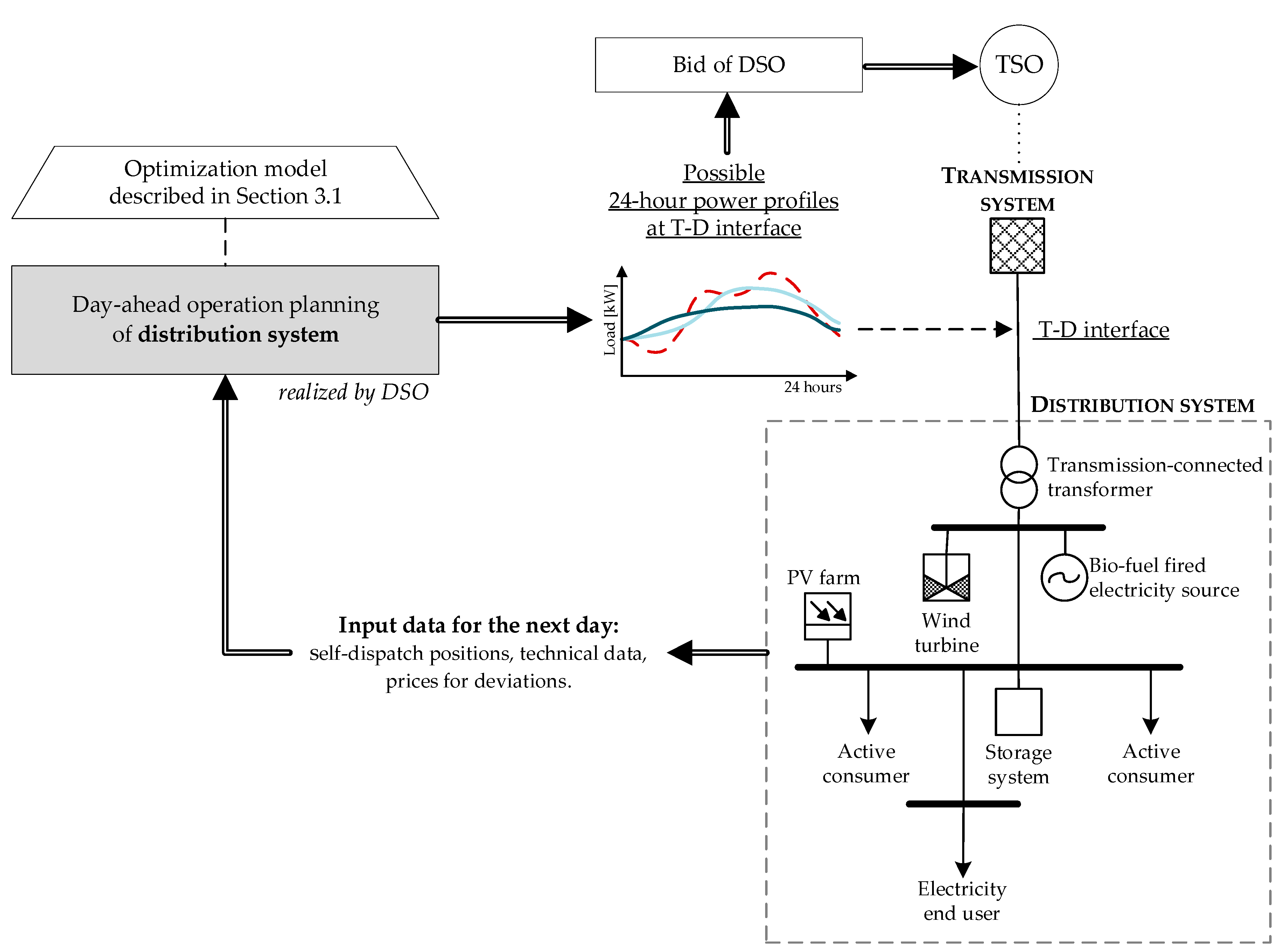
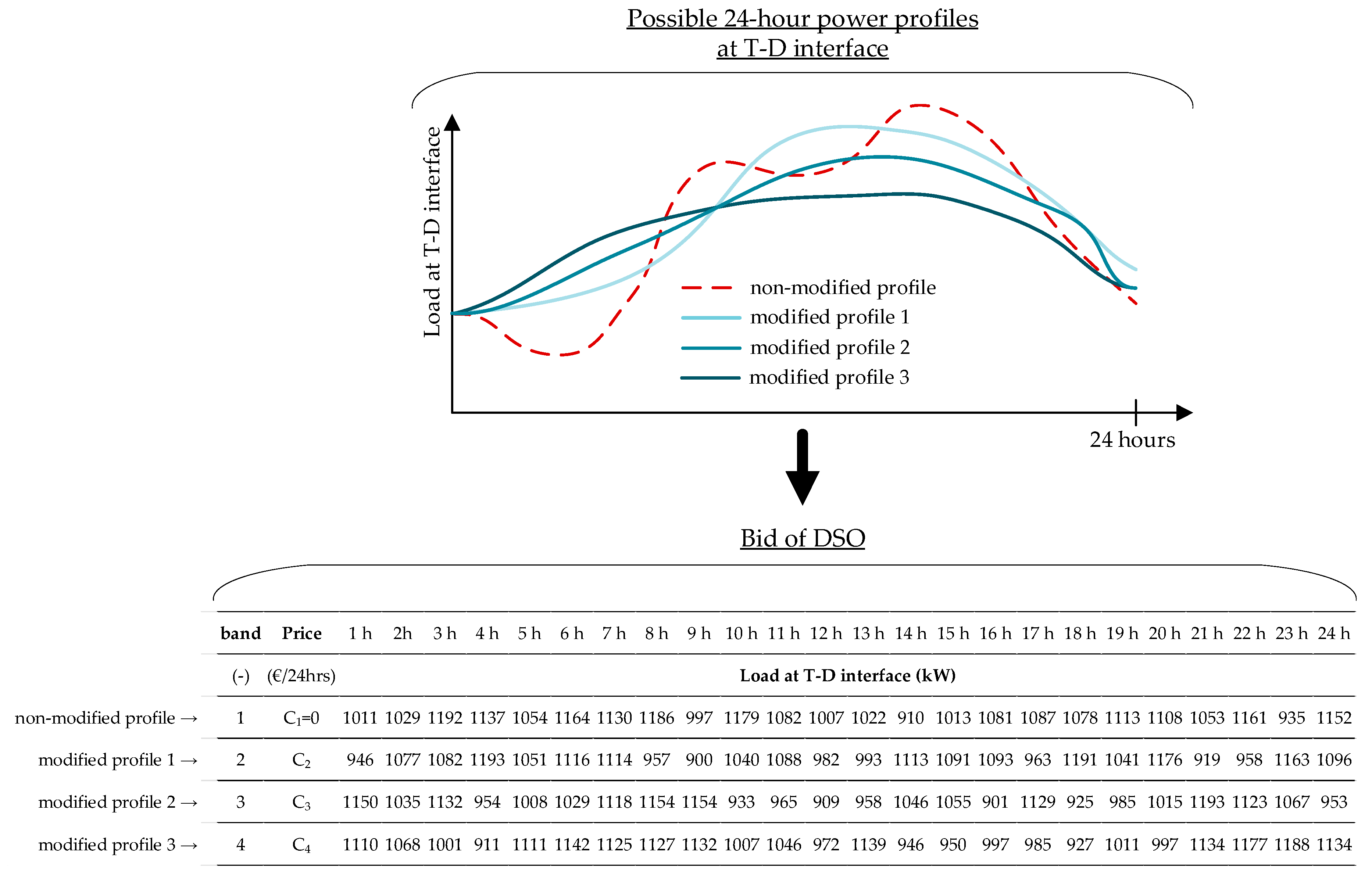
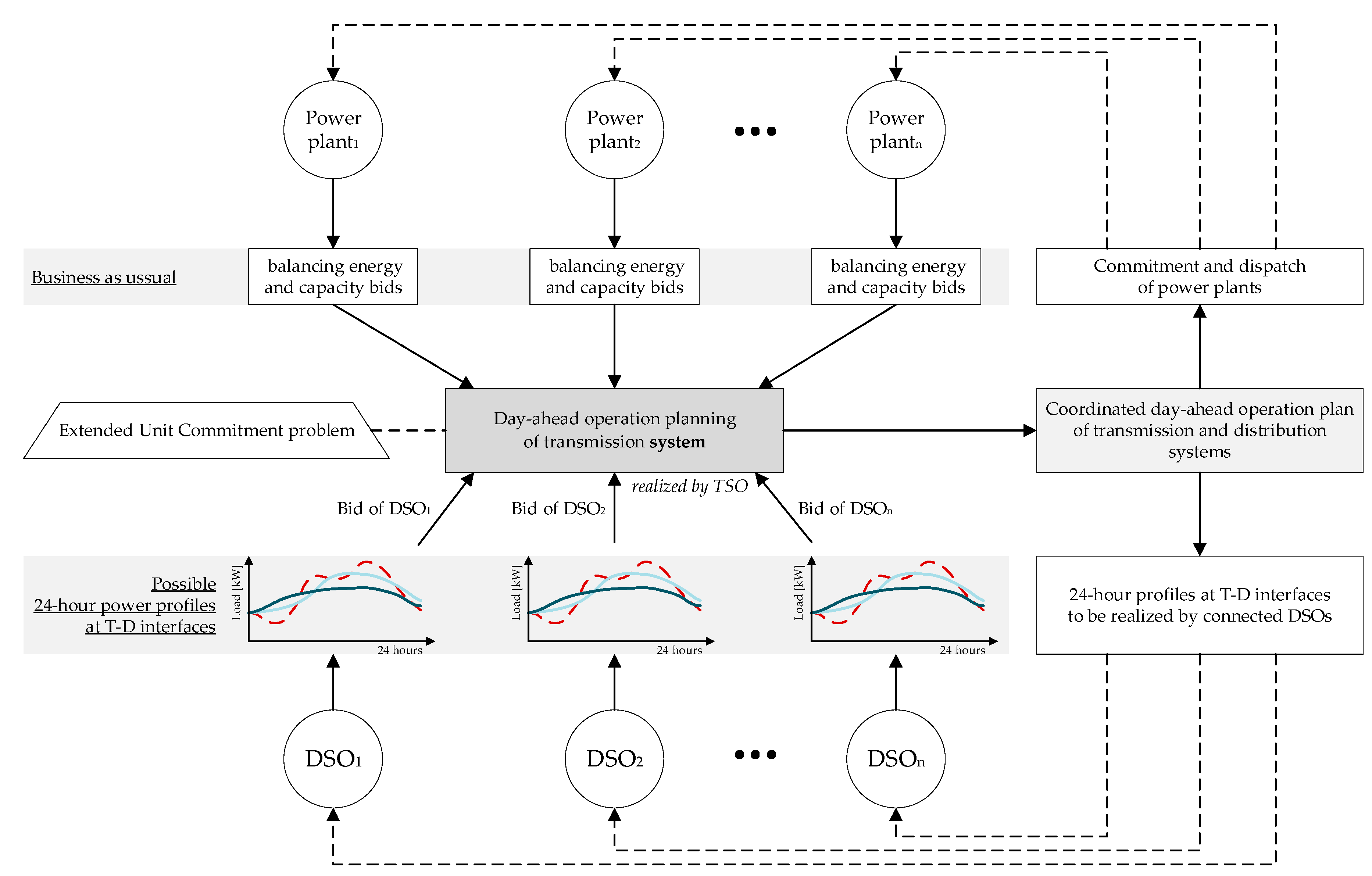

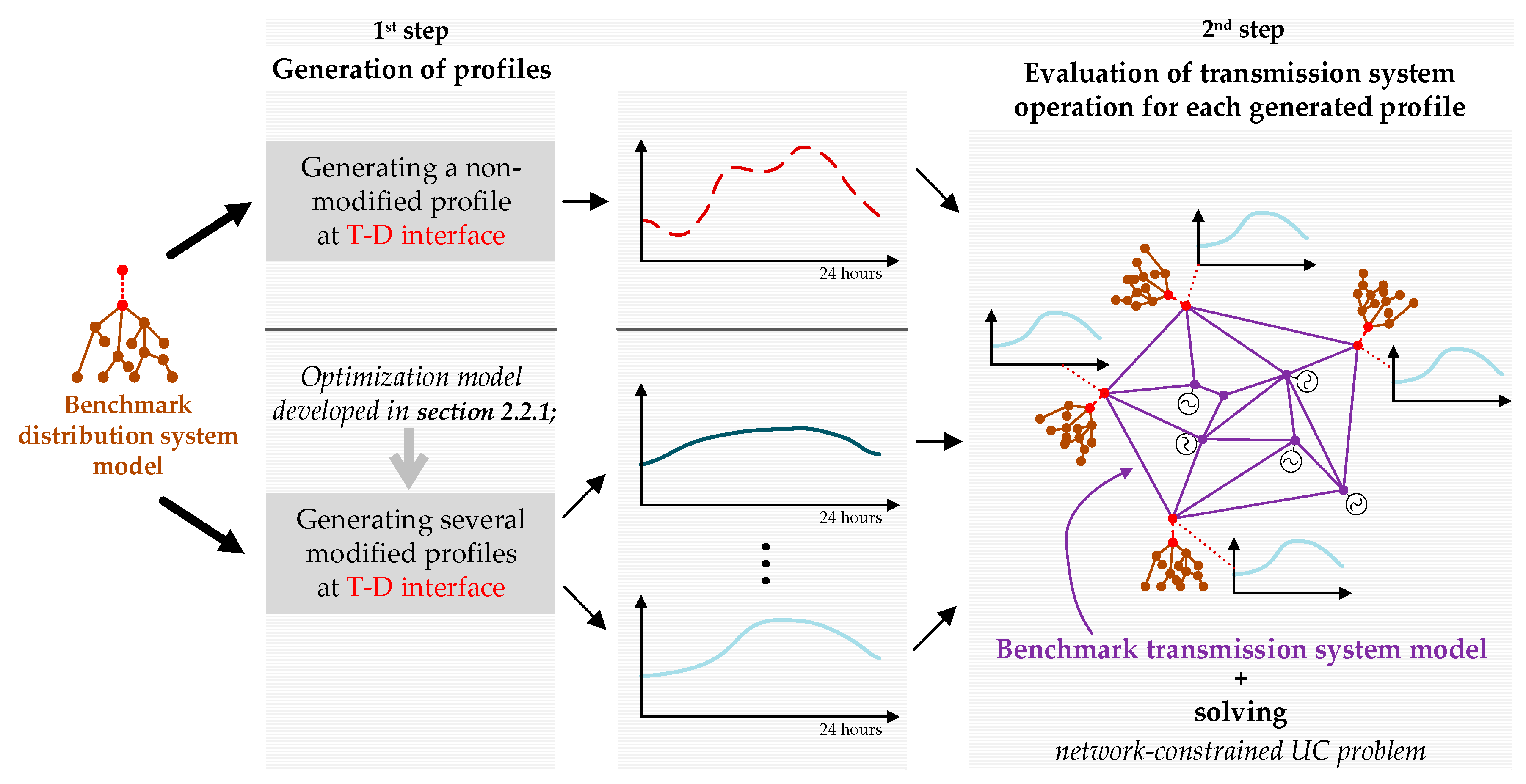
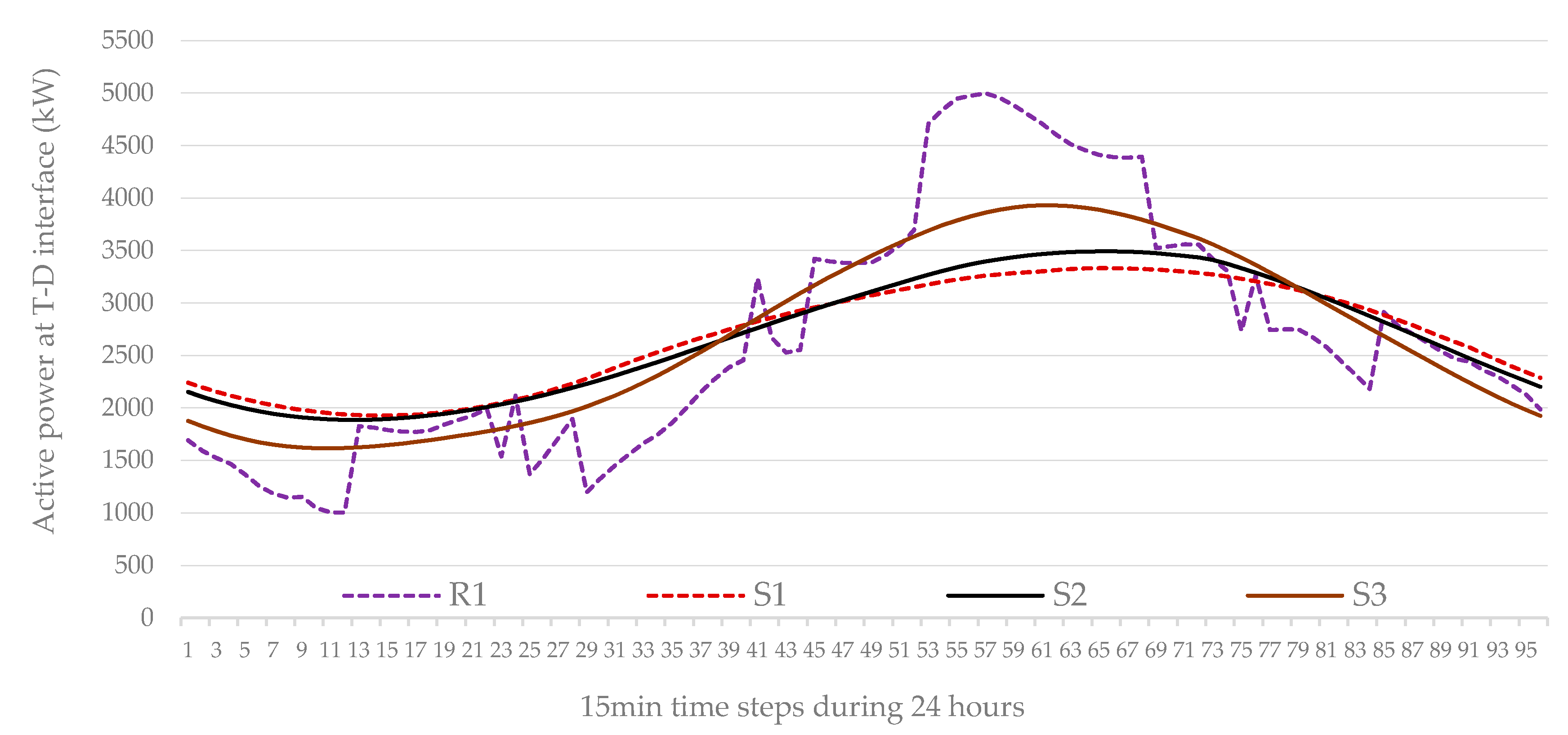
| Scenario | R1 | S1 | S2 | S3 |
|---|---|---|---|---|
| Hot start-ups (-) | 15 | 1 | 3 | 8 |
| Warm start-ups (-) | 0 | 0 | 0 | 0 |
| Cold start-ups (-) | 1 | 0 | 0 | 0 |
| Shut-downs (-) | 16 | 1 | 3 | 8 |
| Occurrences of max ramping (-) | 42 | 3 | 5 | 9 |
| Occurrences of constant output powers (-) | 201 | 269 | 257 | 250 |
| Number of commitments (-) | 24 | 15 | 16 | 19 |
| Commitments w/o break (-) | 8 | 14 | 13 | 11 |
| Scenario: | R1 | S1 | S2 | S3 |
|---|---|---|---|---|
| Peak load (%) | 100 | 67 | 70 | 79 |
| Occurrences of congestions (-) | 22 | 9 | 10 | 11 |
| Scenario: | R1 | S1 | S2 | S3 |
|---|---|---|---|---|
| Startups costs (€) | 468,971 | 34,592 | 62,390 | 161,616 |
| Generation costs (€) | 5,281,027 | 5,245,224 | 5,239,840 | 5,255,042 |
| Total costs (€) | 5,749,998 | 5,279,816 | 5,302,230 | 5,416,658 |
| Max attractive cost of the modified profiles at T–D interfaces (€) | - | 470,182 | 447,768 | 333,340 |
© 2020 by the author. Licensee MDPI, Basel, Switzerland. This article is an open access article distributed under the terms and conditions of the Creative Commons Attribution (CC BY) license (http://creativecommons.org/licenses/by/4.0/).
Share and Cite
Dzikowski, R. DSO–TSO Coordination of Day-Ahead Operation Planning with the Use of Distributed Energy Resources. Energies 2020, 13, 3559. https://doi.org/10.3390/en13143559
Dzikowski R. DSO–TSO Coordination of Day-Ahead Operation Planning with the Use of Distributed Energy Resources. Energies. 2020; 13(14):3559. https://doi.org/10.3390/en13143559
Chicago/Turabian StyleDzikowski, Rafal. 2020. "DSO–TSO Coordination of Day-Ahead Operation Planning with the Use of Distributed Energy Resources" Energies 13, no. 14: 3559. https://doi.org/10.3390/en13143559
APA StyleDzikowski, R. (2020). DSO–TSO Coordination of Day-Ahead Operation Planning with the Use of Distributed Energy Resources. Energies, 13(14), 3559. https://doi.org/10.3390/en13143559





